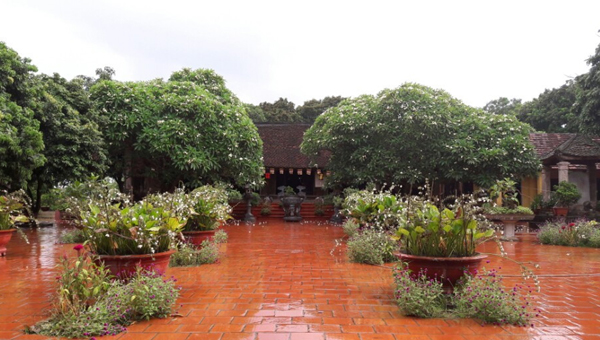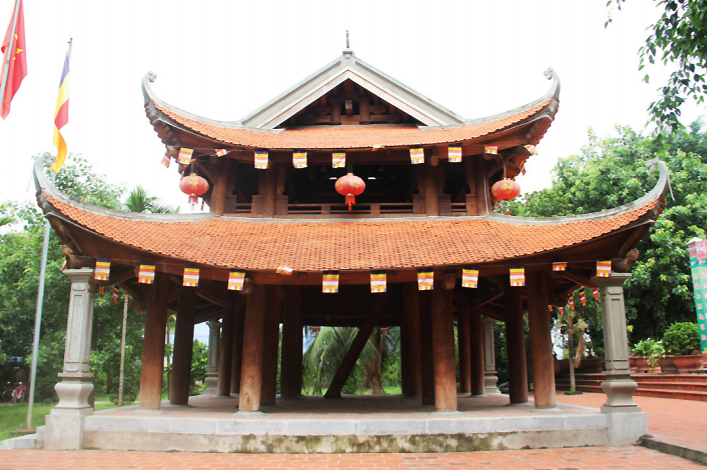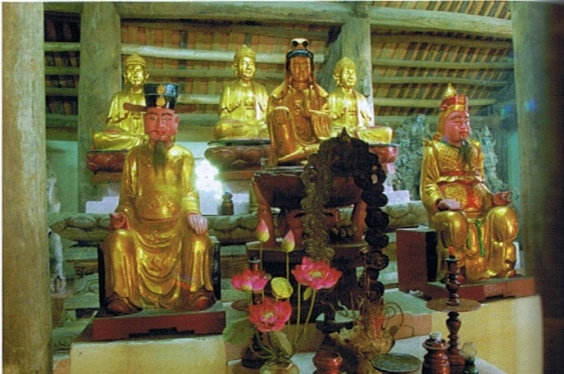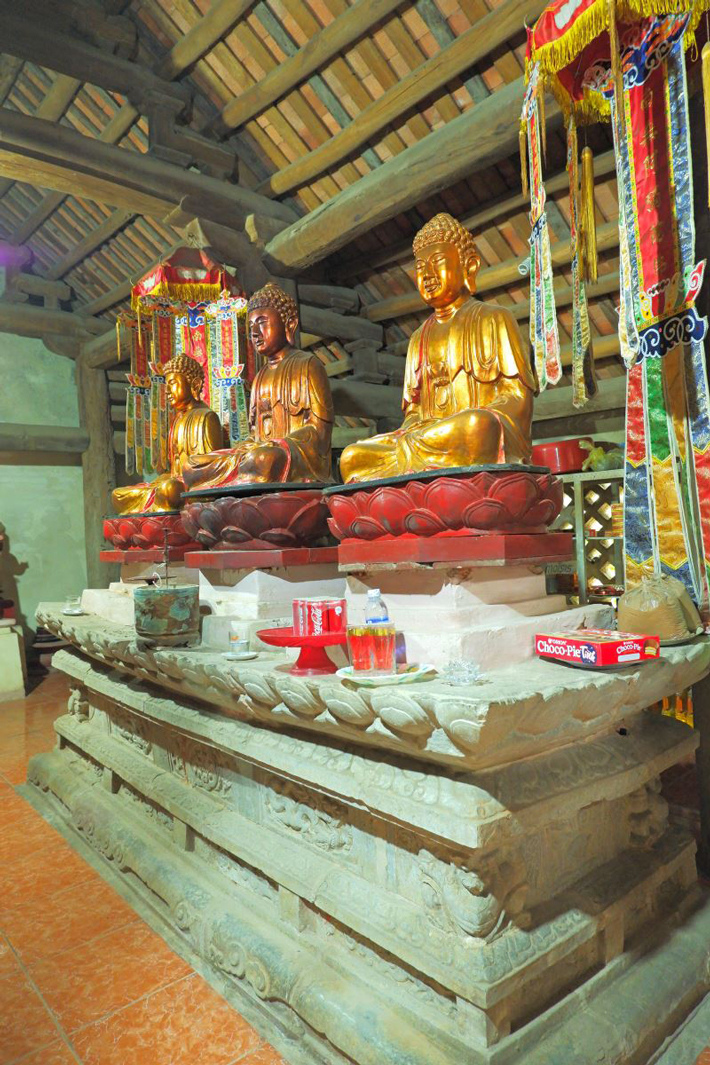Hua Xuan Lung (literal name: Pho Quang Tu), is located on a hill in Chua hamlet, Xuan Lung commune. Xuan Lung Pagoda was built around the beginning of the Tran Dynasty, underwent many renovations, the largest one in 1626 and the most recent in April 2021. The temple is over 800 years old and still preserved. many valuable relics and antiquities.
Tam Quan bell tower – located in the Pho Quang pagoda complex (Photo: Collectibles)

Pho Quang Tu complex consists of basic architectural works: Tam Quan – Bell tower, writer only, Pho Quang pagoda, stele house, and ancestral house. Tam Quan – The steeple at the temple still preserves the ancient architecture in Phu Tho province, with a 2-storey, 8-rod stacked roof system, elegant curved blades, the roof bank is covered with the shape of a dragon rolling water. Thuong Luong engraved Chinese characters: “Hoang million Minh Mang two decades” (ie Minh Mang 12th year – 1839), the heads are carved with lotus flowers. On the steeple hang the bronze bell “Phu Quang Tu Chung” and the bronze bell, both dated in Minh Mang’s second decade – in 1839. The Book of Vietnamese Han-Nom Inscriptions (Hanoi, 1993) summarizes the engraved content. on two stone steles in the temple. A stele created in 1628 said that the pagoda was an ancient temple that was damaged, so in 1626, the Tin Quan, Phu Xuyen served Nguyen Hieu Dung,
Pho Quang pagoda was built in the style of “Cong”, roofed with tiles, and has two levels of pagodas. The upper level pagoda is 10m high, 7m long, including three compartments, with one door leading from the ancestral house to the pagoda. The lower level pagoda is 16m wide, 13.5m long, including 5 compartments. Stone This column has square type, octagonal type with decoration almost leaf. In the middle of the pagoda, there is a great letter and two parallel sentences. Pho Quang Tu has a head-planting style, simple sculpture. The Three Treasures Court includes: Bai Duong, Burning incense and Main hall. The wooden structure frame with the roof sets is made in the style of “Upper price gongs, stacking rams – lowering people”. Xuan Lung Pagoda currently preserves more than 30 statues of wood and earth, arranged on the pedestal.
The main hall at Pho Quang Pagoda (Photo: Collectibles)
The most remarkable architectural art of Pho Quang Pagoda is the lotus stone pedestal made from 71 green stones carved with feats, placed in the middle of the superior pagoda supporting three three world buildings. This is a unique work of art, imbued with the artistic style of the Tran Dynasty. The lotus stone pedestal has a rectangular structure, dimensions: 1.05m high, 1.25m wide, 3.30m long. In which, the stylized lotus petal is the main theme, occupying a dominant position in art. stone pedestal sculpture. Along with the image of a lotus, earthly life is also depicted vividly through folk motifs such as: fish hovering, lions playing, deer pairing branches of begonias in full bloom… Four corners of the pedestal, third and fourth floors There are four stable spirit birds, human-shaped faces, four stylized leaves under the chest, engraved on the forehead with the word “king”, the ankles and body are all tied with flowers…
This is an antique that is not only valuable in stone carving art, but also has Chinese characters dating on it that can be considered as a message from the ancestors to today’s generation. a historical period over 600 years ago, helping us to confirm accurately and absolutely about the date and meritorious people, the most valuable artwork of Phu Tho province. 3rd floor of the stone pedestal The lotus flower record reads: “Xuong Phu decade, Dinh Mao life, two moons and twelve days, the landowner of the primary school, Nguyen Chieu, self-enlightenment, non-layman Nguyen Thi Suu wrote a public confession to create Khanh Tinh Thach court vi. three treasures”. (Translation: On February 12, Dinh Mao year, the 10th year of Xuong Phu year (1388), the landowner studied the marquis Nguyen Chieu and his wife Nguyen Thi Suu, with the self name Cong Tin bowing to the stone court of the three treasures). Box 4 on the front of the stone pedestal reads: “History of Dien Ngu Thu Ha Chinh Thu Nguyen Nap wrote himself Dao Cu Si communist community ban Thach Hoang court residence Tam Bao”. (Translation: The history of Dien Ngu Thu Ha Chinh Thu named Nguyen Na Tu is Dao Cu Si and he entered the temple with the three jewels stone court).
The lotus stone pedestal at Pho Quang Pagoda is over 600 years old (Photo: Collectibles)
The lotus stone pedestal of Xuan Lung Pagoda is a rare and unique sculpture of artistic value remaining from the Tran Dynasty, a heroic era in the nation’s history with the Dong A spirit winning the army 3 times in turn. invade the Mongols. With these special historical, cultural, scientific and practical values, in Decision No. 2198/QD-TTg issued on December 25, 2021 by the Government, the stone Buddha altar at Xuan Lung Pagoda was recognized as a National Treasure.
Pho Quang Pagoda has four main holidays: the full moon of the first month, April 8 (the Buddha bathing ceremony), the full moon of July (the ceremony to erase the sins of the dead) and the 8th day of the 12th lunar month. Pho Quang Pagoda is not only the place where healthy religious activities take place, but also the honor and pride of the villagers. This place was recognized by the Ministry of Culture and Information (now the Ministry of Culture, Sports and Tourism) as a national historical and cultural relic in 1980. This further confirms the great value of the temple in terms of cultural heritage. history, architecture, culture and in the spiritual life of the people. Each of us needs to have a sense of protecting and preserving the ancient temple so that its value remains with time.
Source: Collected internet.


